Sanderson Demar (Dock) Gentry &
Eliza Jane Haney & family
My families ties to the Carbon County area of Utah State centers around my Great Grandmother, Sarah Elizabeth Dickens Gentry, born 29 August 1855 in Springville, Utah, and, her daughter Martha Eveline Sturgis (my Grandmother), born 10 October 1883 in Scofield, Utah.
Sarah Gentry's Father, Sanderson Demar (Dock) Gentry began life about 1827 in Adair County, Kentucky, and departed life in Castle Gate, Carbon County, Utah, in 1897. It is most probably the body of Sanderson Gentry that lies buried beneath a headstone marked "Dox", in the Price City Cemetery, Carbon County, Lot 72, Section A, a lot purchased by Wesley Gentry. Family/Relatives buried on this lot: Henry Christopher Gentry - born 27 Jan 1894 - died 17 Dec 1935; Joseph J. Gentry; Dox Sanderson Gentry; Gene & Jeani Bigelow, twins of Clifford E. & Melvina Lance Bigelow 24 Nov 1940; Robert Elijah Bigelow - born 23 May 1907 - died 10 Feb 1908; Louise Tuttlule Gentry - born 15 Oct 1864 - died 14 Jan 1898; Robert Wesley Gentry - born 10 Sep 1863 - died 17 Feb 1939; May Gentry 1887 - 1962 (shares headstone with A. Elijah Bigelow 1879 - 1947).
Sanderson Gentry's Father, Robert Gentry, was born 3 April 1784, in Fredericksville, Louisa, Virginia to a line of Gentry families going back to the arrival of Nicholas Gentry (my sixth Great Grandfather), a British soldier (Redcoat), arriving in America, 2/11/1677, aboard either the " Rose " or the " Dartmouth." Nicholas and his brother Samuel, being two of 1,130 men sent by the king to quell the " Bacon Rebellion." The Gentry families and their descendents prospered and spread out all across America, and were involved in all of America's history. Gentry' kin can be found on either side of the Revolutionary and Civil Wars – the so-called "Mormon War" in 1838 was no different.
Robert Gentry married Julia Simpson, a native of Washington Co., Georgia, 3 March 1806, in Adair Co., Kentucky. Robert Gentry and Julia Simpson moved their family to Carroll County, Missouri about 1830, just in time for the family to be involved with Joseph Smith and his followers as the Mormon Church was being formed. As far as I have been able to determine, at least three of Sanderson Gentry's sisters: Jane Gentry, Married Riley Stewart; Sara Dickens Gentry, Married William Jackson Stewart; and, Piney Gentry, Married Samuel Mears (or Marrs), were among early members of the Mormon Church. Sanderson's brother, Sampson Gentry, was badly wounded at Dewitt, Carroll County, while a group of citizens he was with were attempting to assist a Capt. Ewing and party, in capturing the Mormon post located there. Sampson Gentry and the other citizens arrived at the Mormon post before Capt. Ewing's party got there, and were mistaken for Mormons by the Capt. Ewing's men and fired on. The members of this Gentry family that joined the Mormon Church moved first to Illinois, then on to Utah as early Mormon Pioneers.
I have found no evidence that Sanderson Demar Gentry ever became a member of the Mormon Church; however, Sanderson, his wife, and their first child arrived in Salt Lake City, Utah, in time to be included in the 1850 Census. Sanderson Gentry married a niece, Eliza Jane Haney, born 1831 in Carroll County Missouri, the daughter of William Haney and Permelia Gentry (Sanderson's sister). The first child of this marriage, Christopher Columbus Gentry, was born in Carroll County Missouri in 1849. A second child, William H. Gentry, was born 1852 in Springville, Utah; and, as mentioned above, my Great Grandmother, Sarah Gentry in 1855. The family moved during the late 1850s, accompanying Mormon Settlers to San Bernadino County, California.
When I was a young boy, my family lived in Ruth, Nevada. My parents often visited friends in a small town near Ely, Nevada called Lund – a stopping place for Mormon Settlers on the move. Discovering now, that my Great Grandfather and family may have been among those settlers, has amazed me. What hardy folks to have walked from Missouri to Salt Lake City; then, a few years later walk from Salt Lake City to San Bernadino.
Sanderson Gentry and family remained in San Bernadino until 1870. Four more children were born to this family in San Bernadino: Sanderson Green Gentry, born 1858 (died before age 8); Robert Wesley Gentry, born 8 September 1860, Permelia Jane Gentry, born 2 June 1863; and Mary S. Gentry, born 1 Sep 1867.
hen the family members returned to Utah, they first settled around Springville, Utah County. Sanderson and Eliza had two more children: Nancy Luella Gentry, born 1871; and, Francis Marion Gentry, born 1874. Son William Gentry married a Springville girl, Sarah D. Elizabeth Starr in 1870; and, their child John Wesley Gentry was born 7 February 1871 in Springville. Christopher Columbus Gentry Married Melina Evelyn Mecham about 1873; and, their child Christopher James Gentry was born 6 November 1874 in Payson, Utah County.
By 1880, the family had moved to Diamond, Juab County. Sanderson and son Christopher were farming, and Son
William was raising Stock. Son Robert Wesley married Louise Jane Tuttle April 1881 in Tintic, Juab County. Daughter
Sarah Elizabeth Dickens Gentry, also living in Diamond, married to a miner, Alfred Henry Sturgis, born 28 Jan 1845 in
Morgan County, Illinois (son of James Sturgis and Louisa Jane Reed).
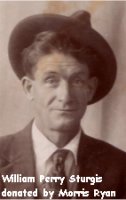 The first child of Alfred Sturges and Sarah was Alfred, Jr., 6 years old in the 1880 Census, born 25 March 1874 Star Ranch, Mona, Juab County. Daughter Sarah Jane born 10 April 1876 and son William Perry Sturgis was born 25 Aug
1880 in Diamond, Juab County..
The first child of Alfred Sturges and Sarah was Alfred, Jr., 6 years old in the 1880 Census, born 25 March 1874 Star Ranch, Mona, Juab County. Daughter Sarah Jane born 10 April 1876 and son William Perry Sturgis was born 25 Aug
1880 in Diamond, Juab County..
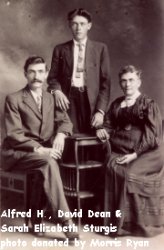 The Sturgis family had moved to Scofield, Carbon County by 1882. Daughter Martha Evelyn was born 10 October 1883 in Scofield. Daughter Mary Ellen was born 27 June 1887; and their last child, David Dean was born 6 January 1892 in
Scofield. Alfred Harvey Sturgis died 30 September 1906 in Diamond, Juab County and is buried in Springville, Utah County. Sarah Elizabeth Dickens Gentry Sturgis died 24 March 1931 at the home of her daughter Martha Sturgis Ryan -- Sarah is buried in the City cemetery, Springville, Utah County.
The Sturgis family had moved to Scofield, Carbon County by 1882. Daughter Martha Evelyn was born 10 October 1883 in Scofield. Daughter Mary Ellen was born 27 June 1887; and their last child, David Dean was born 6 January 1892 in
Scofield. Alfred Harvey Sturgis died 30 September 1906 in Diamond, Juab County and is buried in Springville, Utah County. Sarah Elizabeth Dickens Gentry Sturgis died 24 March 1931 at the home of her daughter Martha Sturgis Ryan -- Sarah is buried in the City cemetery, Springville, Utah County.
Alfred H. Sturgis, Jr., married Carrie Virginia Lemmon 28 September 1898 in Diamond, Juab County. Three children were born to this marriage: Bernall, John, and Rita. Alfred Harvey Sturgis Jr. died 10 February 1930 in Provo, Utah.
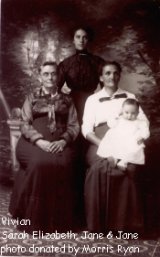 Sarah Jane Sturgis married John Reese 2 July (1905) in Winter Quarters, Carbon County. Five children were born to this family: Vivian, born 30 Jan 1900 Clear Creek, Carbon, died 21 May 1980; Sadie R. born 2 July 1906 in Scofield (married Eligah C. Gentry), Carbon County, Sadie died 2 Jan 1961; John Hector Reese was born 16 May 1896 in Scofield, and died 5 Oct 1987 in Price, Carbon County; William Perry Reese was born 30 March 1908 in Scofield, died 12 Oct 1981 in Salt Lake City; and Mildred born 10 Aug 1912 in Scofield, married Massa. Mildred Reese Massa died 18 April 2001 in Carbon County. John Reese died 18 January 1916 in Scofield. Sarah Jane married twice more: Ben Grithers who died , and Richard (Dick) Jones who moved to Canada. Sarah Jane Sturgis died 19 September 1951 in Helper.
Sarah Jane Sturgis married John Reese 2 July (1905) in Winter Quarters, Carbon County. Five children were born to this family: Vivian, born 30 Jan 1900 Clear Creek, Carbon, died 21 May 1980; Sadie R. born 2 July 1906 in Scofield (married Eligah C. Gentry), Carbon County, Sadie died 2 Jan 1961; John Hector Reese was born 16 May 1896 in Scofield, and died 5 Oct 1987 in Price, Carbon County; William Perry Reese was born 30 March 1908 in Scofield, died 12 Oct 1981 in Salt Lake City; and Mildred born 10 Aug 1912 in Scofield, married Massa. Mildred Reese Massa died 18 April 2001 in Carbon County. John Reese died 18 January 1916 in Scofield. Sarah Jane married twice more: Ben Grithers who died , and Richard (Dick) Jones who moved to Canada. Sarah Jane Sturgis died 19 September 1951 in Helper.
William Perry Sturgis was the most colorful member of this family. William was known as 'Wild Bill' - it was said that while riding a horse at full gallop, William could slide under the horses belly and shoot bottles off of a fence rail with his six shooter. William was a member of the Rough Riders (probably, Troop I of Torrey's Roughriders (a special troop of mounted riflemen-a Utah unit organized for the Spanish American War); and, a pony express rider - rode once, finishing the ride with an indian arrow in his back. When a young man living in Salt Lake City, a drinking buddy of Jack Dimpsey (before Dimpsey went to professional boxing). Jack Dimpsey and William would come home late after roughhousing in the bars in Salt Lake City, and Martha would have to patch them up. William Perry Sturgis died 6 May 1946. William Perry Sturgis married Ann Mae (Annie P.) RIECK, 23 Nov 1899 in Payson, Utah Co. Utah. Three children were born to this union, James, Louisa and Perry. When Anna Mae died, Perry was sent to Idaho to work on a ranch. Louisa became a nun. James was adopted by a navy man who took him back east--never heard from or about again.
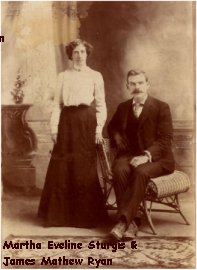 Martha Eveline Sturgis, my Grandmother, met my Grandfather James Mathew Ryan at one of these mining areas and married 17 February 1902 in Salt Lake City. Seven children were born to this family while they were living in Silver City and Provo areas of Utah County. The family eventually moved to Ruth, Nevada. Martha Eveline Sturgis Ryan died 12
November 1965 in Ely, Nevada.
Martha Eveline Sturgis, my Grandmother, met my Grandfather James Mathew Ryan at one of these mining areas and married 17 February 1902 in Salt Lake City. Seven children were born to this family while they were living in Silver City and Provo areas of Utah County. The family eventually moved to Ruth, Nevada. Martha Eveline Sturgis Ryan died 12
November 1965 in Ely, Nevada.
James Mathew Ryan was born 9 September 1875 in Schenectady, New York, a son of Irish immigrants from Doon,
County Limerick, Ireland. James, his brother William, a sister Anna, and a second sister, Mary with her husband Michael Powers and children came west. William Ryan was killed in a mining accident in Bingham Canyon in 1902. Michael Powers died because of or during, an appendectomy in Salt Lake City August 1901. Mary Ryan Powers took her family back to New York. Anna Ryan never married. Anna eventually settled in Salt Lake City and cooked for miners at her apartment in the Eagle Gate Apartments.
Mary Ellen Sturgis married John William Woodward 5 January 1902 in Diamond, Juab County. Five children were born to this family: Mary Ellen, Darward, David Dean, Beulah, and Afton Eveline. Mary Ellen Sturgis died 29 May 1949 in Orem, Utah County.
David Dean Sturgis was married twice with no children to either marriage. David Dean Sturgis died 15 February 1967 in Ely, Nevada.
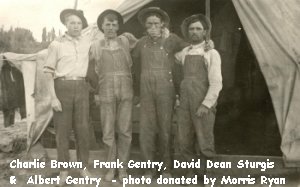 The Gentry family also had moved to Carbon County by 1882. Eliza Jane Haney Gentry died in Scofield in 1882 and was buried in Springville Cemetery, Utah County. As mentioned earlier, Sanderson Demar Gentry died in Castle Gate, Carbon County January 1897 and is buried in the Price cemetery, Carbon County.
The Gentry family also had moved to Carbon County by 1882. Eliza Jane Haney Gentry died in Scofield in 1882 and was buried in Springville Cemetery, Utah County. As mentioned earlier, Sanderson Demar Gentry died in Castle Gate, Carbon County January 1897 and is buried in the Price cemetery, Carbon County.
Sanderson's son Robert Wesley Gentry and wife Louise Tuttle had also moved to Scofield, Carbon County by 1882. The first child of this marriage was Francis Wesley Gentry, born 24 April 1882 in Scofield, Carbon County. Daughters Liza Luella born 1 June 1886, and Mary Jane born 10 October 1887 were also born in Scofield. The next child, daughter Maudie Desty was born 1891 in Tintic, Juab County. A son Christopher Henry was born 27 January 1894 in Price, Carbon County, and another daughter Alice Delia born 24 April 1896 in Scofield. The last child Rosie Evelyn Gentry born 14 January 1899 died at birth and the mother, Louise apparently died at the same time or shortly after. Robert Wesley Gentry married a second time to Sarah Hansen 17 June 1908 in Spring Glen, Carbon County. Robert Wesley Gentry died 17 February 1939, Spring Glen, Carbon County.
Sanderson's daughter Permelia Jane Gentry married John Lorenzo Brooks July 1880 in Provo, Utah County. This couples first two children were born in Diamond, Juab County: John Jr. born 10 Jan 1882, and Mary Jane (Mame) born 10 March 1883. The next two children: William Henry 8 September 1884, and Ella Evelin (Eve) 4 July 1886, were born in Scofield, Carbon County. Other children born to this marriage were Sadie, Sarah Ann; born 19 September 1894 in Scofield; Vivian Reece, born 30 January 1900; Mildred and Josephine. Permelia Jane Gentry Brooks died 7 June 1945 and is buried at Provo, Utah County.
Sanderson's son Francis Marion Gentry married Mary Elizabeth Jenkins 30 June 1895. Children born to this couple were Francis; William Charles; Violet Rose; Elizabeth (Rennie); Lucille; Rachel Ann, born 18 July 1901 in Sunnyside, Carbon County; Bernard; and Mary Jane. Francis Marion Gentry died 14 August 1936 in Price, Carbon County.
Sanderson's daughter Rose Evelyn Gentry married John William McGuire. This family lived on a ranch near Price Utah. My family best remembers Rose as a fantastic horsewoman. Rose Evelyn Gentry McGuire died 14 September 1937.
Sanderson's daughter Nancy Luella Gentry married Brigham Hamilton. Nancy Luella Gentry Hamilton died 9 August 1929.
Sanderson's son Christopher Columbus Gentry married a second time to Rhoda Mary Bishop 6 Jul 1897, in Gordon Creek, Carbon Co., Utah. Christopher's son Christopher James Gentry married Rhoda's sister, Agnes Frances Bishop 15 September 1898, also in Gordon Creek, Carbon Co., Utah. Christopher Columbus Gentry was involved in a court case immediately before his death, Columbus Gentry Etal. Vs. Rio Grande Western Ry Co. - still in progress at the time of the death of Columbus Gentry. Christopher Columbus Gentry committed suicide by hanging, 17 September 1899.
The principal parties in this story, as well as their children, seemed to move freely between Utah, Juab, and Carbon Counties. I only imagine the cause for this movement was the availability of work at the various mines.
The sources for the dates and names in this family history were from: notes of conversation, family records, and photographs maintained by my cousin Marjorie Willott; Family group records prepared by another cousin whom I haven't met, Leland Homer Gentry; and, probably most importantly, the wonderful assistance provided me as I searched through films by Kathy Hamaker at the Family History Center in Price. The next time you visit Price, take a stroll down Gentry Lane and say hello to my cousins living there.
This story was donated by Ryan Morris if you are interested in more information about this family please contact him.